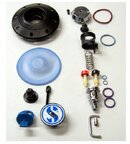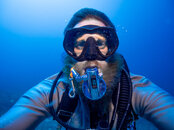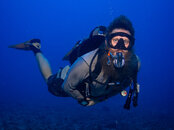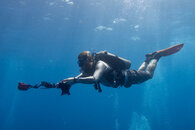Redbeard04
Registered
I just acquired an Air1 converted Scubapro Pilot that came with a MK9 first stage off of ebay. Today I hooked them both up and tested them, both were in need of a rebuild with the 1st stage IP at 125 @ 500 psi and over 180 at 3000 psi and the pilot free flowing on a good 1st stage set to 138 psi.
I cleaned and rebuilt both and after some tuning with shims and seats I was able to get the MK9 to stay within 135-145 @ 500 and 3000 psi. So far so good. After cleaning and reassembling the pilot I tuned it with the set screw just off of a free flow and the spring cap screwed most of the way down where it seemed happy to seal up and not free flow. Test breathing felt very light on inhalation and exhalation and the magnahelic confirmed it is cracking at about .7 inches. Checking WOB on the flow meter shows it very quickly goes from less than .5 inches resistance to -1, -2, then off the scale past -5 inches above 15 scfm.
I'm all for a low WOB, but would like to avoid excessive positive pressure forcing me air at depth. The pilot tuning instructions reference tuning the aspirator gate much like you would a D400, however the example I have doesn't have one. I wasn't able to find an Air 1 repair guide so I don't know if it follows the same procedure of not. The local SP rep said that the air 1 didn't have a means of tuning the venturi effect and is just always wide open.
So I guess what I'm asking is does the Air 1 and/or converted pilot have a means of tuning the venturi effect? Is my example missing an aspirator gate, and if so what is the best way of sourcing one? This is a regulator I'd like to dive, but I'd rather see it's air delivery a bit more civilized before taking it to depth.
I cleaned and rebuilt both and after some tuning with shims and seats I was able to get the MK9 to stay within 135-145 @ 500 and 3000 psi. So far so good. After cleaning and reassembling the pilot I tuned it with the set screw just off of a free flow and the spring cap screwed most of the way down where it seemed happy to seal up and not free flow. Test breathing felt very light on inhalation and exhalation and the magnahelic confirmed it is cracking at about .7 inches. Checking WOB on the flow meter shows it very quickly goes from less than .5 inches resistance to -1, -2, then off the scale past -5 inches above 15 scfm.
I'm all for a low WOB, but would like to avoid excessive positive pressure forcing me air at depth. The pilot tuning instructions reference tuning the aspirator gate much like you would a D400, however the example I have doesn't have one. I wasn't able to find an Air 1 repair guide so I don't know if it follows the same procedure of not. The local SP rep said that the air 1 didn't have a means of tuning the venturi effect and is just always wide open.
So I guess what I'm asking is does the Air 1 and/or converted pilot have a means of tuning the venturi effect? Is my example missing an aspirator gate, and if so what is the best way of sourcing one? This is a regulator I'd like to dive, but I'd rather see it's air delivery a bit more civilized before taking it to depth.







